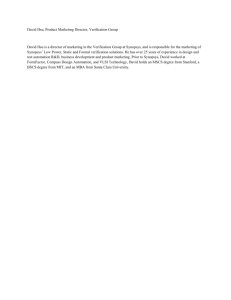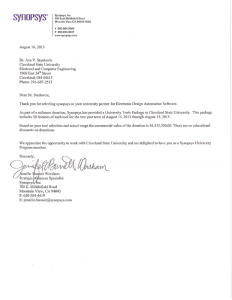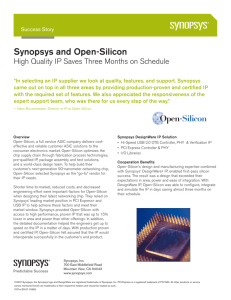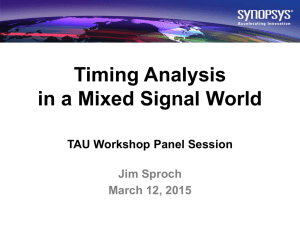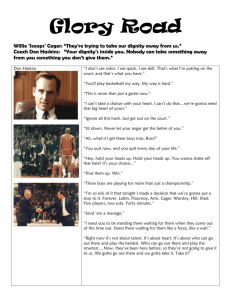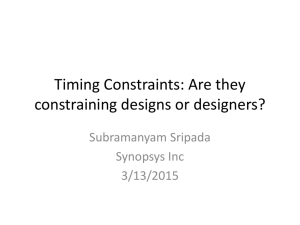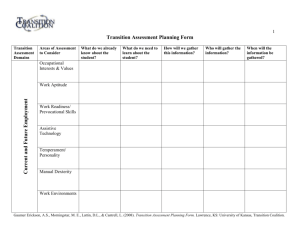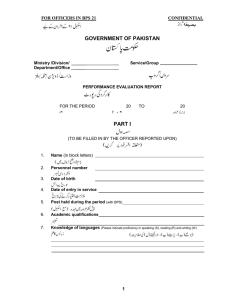System-on-a-Chip and Interfaces
advertisement
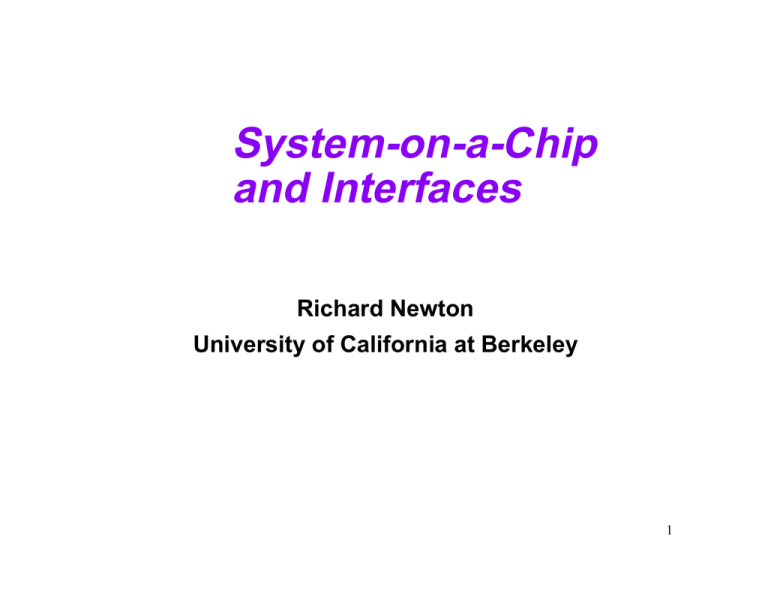
System-on-a-Chip and Interfaces Richard Newton University of California at Berkeley 1 System on a Chip Framework in Which to Understand IMPACT OF SUBSTITUTION Modems shipped to North America Unit price, $ 350 300 250 200 150 9,600 bps or less 100 50 0 1992 1993 1994 1995 1996 1997 1998 1999 Projected Source: Dataquest; McKinsey analysis 2000 IMPACT OF SUBSTITUTION Modems shipped to North America Unit price, $ 350 300 19,200 bps 250 200 150 9,600 bps or less 100 50 0 1992 1993 Source: Dataquest; McKinsey analysis 1994 1995 1996 1997 1998 1999 Projected 2000 IMPACT OF SUBSTITUTION Modems shipped to North America Unit price, $ 350 28,800 and 33,600 bps 300 19,200 bps 250 200 150 9,600 bps or less 100 50 0 1992 1993 Source: Dataquest; McKinsey analysis 1994 1995 1996 1997 1998 1999 Projected 2000 IMPACT OF SUBSTITUTION Modems shipped to North America Unit price, $ 350 28,800 and 33,600 bps 300 19,200 bps 250 200 150 56 Kbps 9,600 bps or less 100 50 0 1992 1993 Source: Dataquest; McKinsey analysis 1994 1995 1996 1997 1998 1999 Projected 2000 IMPACT OF SUBSTITUTION Modems shipped to North America Unit price, $ 350 28,800 and 33,600 bps 300 19,200 bps 250 200 150 100 Avg ASP 56 Kbps 9,600 bps or less 50 0 1992 1993 Source: Dataquest; McKinsey analysis 1994 1995 1996 1997 1998 1999 Projected 2000 WORLDWIDE SEMICONDUCTOR REVENUES GROWING RAPIDLY Merchant semiconductor sales, $ Billions 350 300 250 200 14% 1996-2000 CAGR 150 100 21% 1990-96 CAGR 50 19% 1985-90 CAGR 0 1985 Source: 1990 ICE, Dataquest 1995 2000 PC INDUSTRY LARGE DRIVER OF GROWTH FROM 1985-1995 $ Billions 150.2 0.4 Military/ civil Industrial/ aerospace transportation 14.1 21.1 Consumer 22.3 19.1 Communications Non-PC computing 27.1 46.1 PCs 1985 CAGR Source: Dataquest; ICE status 1995 34% 14% 21% 14% 14% 1% PCs AND COMMUNICATIONS EXPECTED TO DRIVE GROWTH THROUGH 2001 $ Billions Military/ 0.8 Industrial/ civil 17.7 transpor- aerospace Consumer 20.1 tation Communications 31.3 Non-PC 14.6 Computing PCs 65.4 150.2 300.1 1995 CAGR Source: Dataquest (October 1997) 2001 14% 10% 14% 10% 11% 8% WINNERS HAVE PROFITED HANDSOMELY Financial performance of leading players Segment Company Memory (mostly DRAM) Micron Microprocessors Intel Programmable logic ICs Xilinx Average operating margins, 1992-96 23 34 32 TSMC Source: 10Ks; McKinsey Corporate Finance Practice; Annual reports 42 42 27 32 Foundry Average ROIC, 1992-96 Percent 25 UNATTRACTIVE INDUSTRY RESULTS Economic profit margin of U.S. semiconductor companies Percent 40 30 20 10 Created value 0 -10 Destroyed value -20 -30 1970 1975 1980 1985 1990 1997 Note: Economic profit margin is weighted (ROIC-WACC) for AMD, Analog, Cypress, IDT, Intel, LSI Logic, Micron, National, VLSI (and TI from 1995) Source: Annual reports; Compustat INTEL’S PROFITABILITY HAS CARRIED THE INDUSTRY Average ROIC, 1990-97 37.6 12.9 Average WACC = 13.2 Intel The rest * Includes AMD, Analog Devices, Cypress, Cirrus Logic, LSI, Micron, National, VLSI, and TI Source: Annual reports; Compustat Background The Seven Views of Computer Systems Bell, Mudge & McNamara Source: Bill Lattin, Synopsys The Seven Views of Computer Systems View One: Structural Levels of a Computer System View Two: Levy’s Levels of Interpreters View Three: Packaging Levels of Integration View Four: A Marketplace View of Computer Classes View Five: An Applications/Functional View of Computer Classes View Six: The Practice of Design View Seven: The BLAAUW Characterization of Computer Design Source: Bill Lattin, Synopsys View One: Hierarchy of Computer Levels Adapted from Bell and Newell [1971] Source: Bill Lattin, Synopsys View Two: A Hierarchy of Interpreters [Levy, 1974] Source: Bill Lattin, Synopsys View Three: Packaging Levels of Integration ■ This is a Structural View That Packages the Various Components (Hardware and Software) into Levels. The Levels for DEC Computers in 1978 Were as Follows: ➝ 9 ➝ ➝ ➝ ➝ ➝ 8 7 6 5 4 ➝ 3 ➝ 2 ➝ 1 Applications Applications Components Special Languages Standard Languages Operating Systems Cabinets (to Hold Complete Hardware Systems) Boxes Modules (Printed Circuit Boards) Integrated Circuits Source: Bill Lattin, Synopsys View Four: A Marketplace View of Computer Classes Price vs. Time for Each Machine Class Source: Bill Lattin, Synopsys View Five: An Applications/ Functional View of Computer Classes ■ PMS Level Configuration: A Configuration is Chosen to Match the Function to Be Performed. The User (Designer) Chooses the Amount of Primary Memory, the Number and Types of Secondary Memory, the Types of Switches, and the Number andTypes of Transducers to Suit His Particular Application. ■ Physical Packaging: Special Environmental Packaging is Used to Specialize a Computer System for Certain Environments, Such as Factory Floor, Submarine, or Aerospace Applications. ■ Data-type Emphasis: Computers are Designed with Data-types (and Operations to Match) that are Appropriate to Their Tasks. Some Emphasize Floating-point Arithmetic, Others String Handling. Special-Purpose Processors, Such as Fast Fourier Transform Processors,Belong in This Category Also. ■ Operating System: The Generality of the Computer is Used to Program Operating Systems That Emphasize Batch, Time Sharing,Real-Time, or Transacting Processing Needs. Source: Bill Lattin, Synopsys View Six: The Practice of Design Hardware Development Costs for Developing a $50K Processor in ‘74 [Phister,1976] Source: Bill Lattin, Synopsys View Seven: The Blaauw Characterization of Computer Design Characteristics of Design Areas Architecture Implementation Realization Purpose Function Cost and Performance Buildable and Maintainable Product Principles of operation Logic design Release to manufacturing Language Written algorithms Block diagram, expressions Lists and diagrams Quality measure Consistency Broad scope Reliability Meanings (used herein) ISP Machine ISP RT level machine; microprogrammed sequential machine (at logic level) Physical realization; physical implementation Source: Bill Lattin, Synopsys The Five Views of System on a Chip View One: Semiconductor Process & Packaging View View Two: IP Functional View View Three: IP Design Methodology View View Four: System Design Methodology View View Five: System Software View Source: Bill Lattin, Synopsys View One: Semiconductor Process & Packaging View ■ SIA Roadmap ➝ T HE CHALLENGES OF CHANGING CHIPS Ca te gory Proble m Ke y parame te rs tendency Complexity increase W ill challenge fault isolation Tre nds 1995 1998 2001 2004 2007 2010 12 14 26 50 210 430 900 4-5 1350 5 2000 5-6 2600 6 3600 6-7 4800 7-8 Chip size 250 mm 2 300 mm 2 360 mm 2 430 mm 2 520 mm 2 620 mm 2 Number of logic transistors, in millions I/O Wiring levels Dimension W ill require Minimum feature size 0.35 µm 0.25 µm 0.18 µm 0.13 µm 0.1 µm 0.07 µm decrease higher-powered, slower inspection Minimum defect size Interlevel contact diameter Gate dielectric thickness 0.12 µm 0.4 µm 0.08 µm 0.28 µm 0.06 µm 0.2 µm 0.04 µm 0.14 µm 0.03 µm 0.11 µm 0.02 µm 0.08 µm 7-12 nm 4-5 nm 4-5 nm 4-5 nm <4 nm <4 nm Logic clock speed Threshold voltage variation 350 MHz 70 mV 450 MHz 50 mV Supply voltage Metal wiring 2.5-3.3 V 1.2-2.5 V 1.2-1.8 V 1.2-1.5 V AI Performance acceleration New materials New styles of packaging W ill raise sensitivity to subtle, hard-to find facts W ill need new delayering techniques W ill force physical fault isolation to be done from back of chip Insulator Flip-chip, chip-on-board (COB), chip-on-chip Oxide − 600 MHz 800 MHz 1000 MHz 1100 MHz 40 mV 30 mV 25 mV 20 mV <1.2 V a AI, Cu <1.2 V a Oxide, air, polyimide, low dielectric − − − − − Data from National Technology Roadmap f or Semiconductors, 1994, Semiconductor Industry A ssociation Source: Bill Lattin, Synopsys Conclusions From View One ■20M Gates will be Here in 2000 ■Multiple Power Supplies will Require DCL Descriptions (Equations vs Tables) ■Copper is Here Now (6 Layers) ■Trench DRAM Hybrid Process in 1999 ■I/O Continue to Grow (Power Management EMI Analysis & Synthesis) Source: Bill Lattin, Synopsys View Two: IP Functional View ■ Microprocessor ■ Memory Sub System ■ ASIC (Customer’s Logic) ■ DSP ■ RF (Analog) ■ Mixed Signal ■ I/O Systems ■ On Chip Bus Source: Bill Lattin, Synopsys In te gr at io n An al ys is Cr ea tio n View Three: IP Design Methodology System RTL Physical Source: Bill Lattin, Synopsys System-on-a-Chip IP Creation and Analysis Flow Architectural Design Digital Control Memory Datapath RTL Functional Description Memory Behavior Model Logic Synthesis Logic Design & Simulation Decoder/ Periphery Design Logic Verification Performance Optimization Core Cell Sense Amp Datapath Compiler Analog Analog Functional Model Analog Circuit Design & Sim. Custom Layout Std Cell P&R Chip Assembly Block P&R DRC/LVS/Extraction Parasitic Reduction Final Power & Reliability Check Full Chip Timing Verification Full Chip Func Simulation Source: Bill Lattin, Synopsys System-on-a-Chip Design Flow Architectural Design Digital Control Memory Datapath RTL Functional Description Logic Synthesis Logic Design & Simulation Logic Verification Performance Optimization Datapath Compiler Global Timing/Power Memory Behavior Model Analog Analog Functional Model Decoder/ Periphery Design Block Timing/Power Core Cell Sense Amp Analog Circuit Design & Sim. Custom Layout Physical Floorplan Std Cell P&R Chip Assembly Block P&R DRC/LVS/Extraction Parasitic Reduction Final Power & Reliability Check Full Chip Timing Verification Static Timing Models Functional Models Full Chip Func Simulation Source: Bill Lattin, Synopsys System-on-a-Chip Integration Flow 3ODQQLQJ Physical Manufacturing Reliability 6\VWHP'HVLJQ Power Noise System Hardware/Software Partitioning Timing Test System Physical Floorplan 6\VWHP9HULILFDWLRQ 6\VWHP$EVWUDFWLRQ Functional Power Models Timing Models Bus Functional Models Models Software Source: Bill Lattin, Synopsys View Four - System Design Methodology ■ Problems Migrate to the IP Block Boundaries ■ IP Blocks Effect Each Other ■ Tools Must Enforce IP Block Boundaries ■ IP Blocks Need Different Analysis Tools ✔Digital IP Blocks ✔Mixed Signal IP Blocks ✔RF IP Blocks ✔Memory IP Blocks Source: Bill Lattin, Synopsys SoC Model Views Bus Functional Full Function Cycle Timing Model Full-Function with Timing Software Design Set Physical Design n e tur tec i h Arc Power Design uctio Manufacturing Design Testbench/Tests Instr Automatic Model Creation Integration Timing Design Core Design Core Views Functional Design Core Creation Test Model Post-Design Remodeling Floorplan/Phy Model Electrical Rule Model Place & Route and Chip Finishing Source: Bill Lattin, Synopsys Tradeoffs Among Types of System Designs High Flexibility Low Low High Predictability, performance, and complexity Source: Bill Lattin, Synopsys
